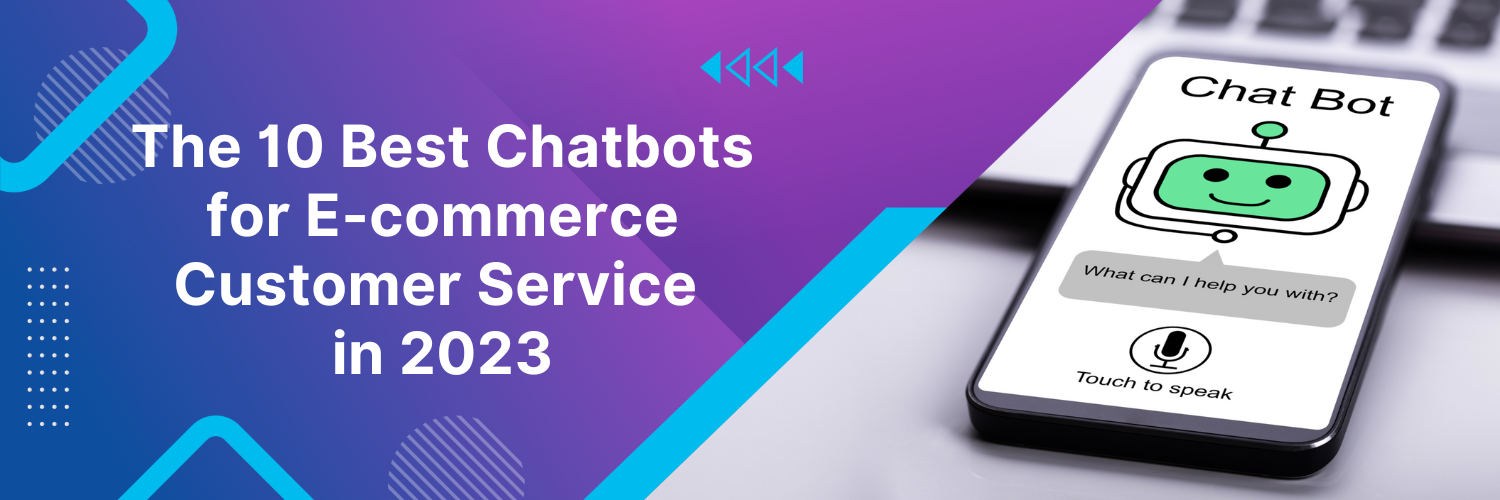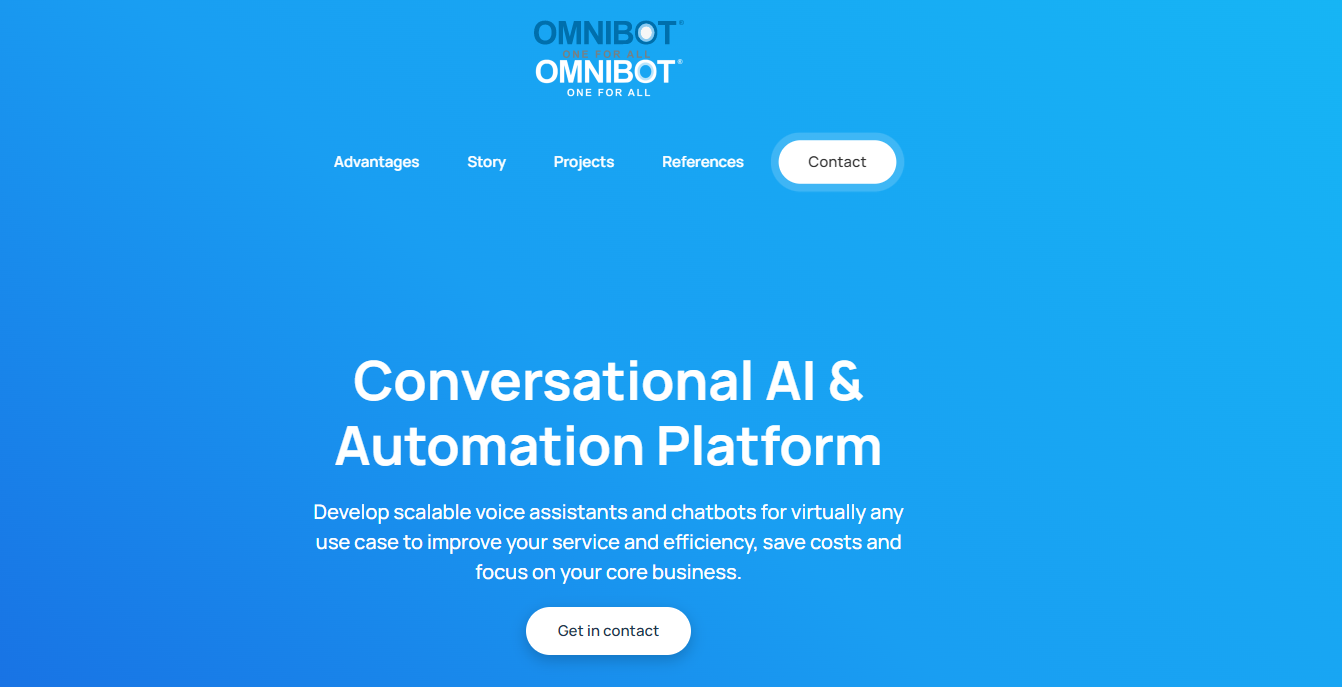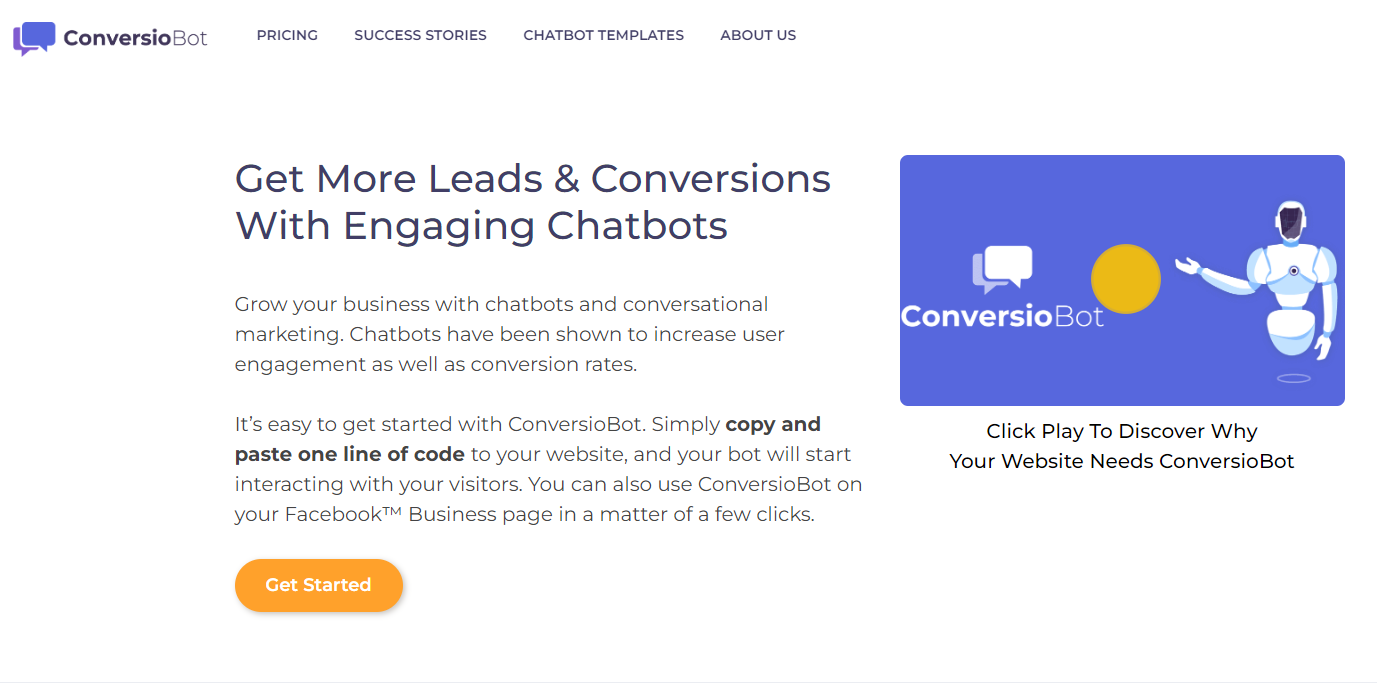E-commerce Customer Service and Chatbots
As e-commerce continues to dominate the global retail market, businesses are increasingly focusing on improving customer service to enhance user experience and stay competitive. Chatbots, powered by artificial intelligence (AI), have emerged as a game-changing solution for providing efficient and responsive customer service in the e-commerce industry. This blog post explores the role of chatbots in e-commerce customer service and how businesses can leverage them to boost customer satisfaction and retention.
What is Chatbot Technology?
Chatbots are computer programs that simulate human conversation. They can answer questions, provide information, and suggest products. Chatbots can be rule-based or use artificial intelligence to understand and respond to queries. They supplement human activity and provide automated customer support 24/7. The benefits of chatbots include increased customer satisfaction, reduced business costs, and personalized customer experiences. Chatbots can be used on various platforms like Messenger, Telegram, and social networks. They work best when used alongside human-powered channels like live chat and video chat.
The Role of E-commerce in Modern Business
E-commerce has become an essential part of modern business, allowing companies to reach customers from all corners of the world with ease. It has revolutionized the way consumers shop and interact with businesses, making it crucial for businesses to adapt their customer service strategies to meet the growing demand for personalized and convenient online support.
What is Customer Service in E-commerce?
Customer service in e-commerce refers to the process of assisting and guiding online customers throughout their shopping journey. This includes answering product-related questions, providing shipping and payment information, resolving issues, and offering post-purchase support. High-quality customer service is a critical factor in fostering customer loyalty and ensuring long-term success in the e-commerce industry.
Chatbots in E-commerce Customer Service
Chatbots have become increasingly popular in e-commerce customer service due to their ability to provide instant support and personalized assistance. They use AI and natural language processing (NLP) to understand and respond to customer inquiries, making them an efficient and cost-effective solution for addressing a wide range of customer service needs.
The Benefits of Using Chatbots in E-commerce
24/7 Customer Support
Chatbots provide round-the-clock assistance, ensuring that customers can receive immediate help whenever they need it. This is particularly important in e-commerce, where customers may be shopping at any hour of the day and expect quick responses to their queries.
Cost-Effective Support Solution
By automating routine customer service tasks, chatbots help businesses save on labor costs and resources. They also enable companies to scale their customer support efforts without significantly increasing overhead expenses.
Improved Customer Experience and Engagement
Chatbots provide personalized and instant support, enhancing the overall customer experience. By engaging customers in interactive and meaningful conversations, they can drive higher customer satisfaction and encourage repeat purchases.
Enhanced Efficiency and Productivity
Chatbots can handle multiple customer inquiries simultaneously, reducing wait times and streamlining the customer service process. This enables human customer service agents to focus on more complex issues that require their expertise and attention.
How Chatbots are Transforming E-commerce Customer Service
Chatbots have become an integral part of many e-commerce customer service strategies, providing immediate support and helping businesses deliver a more seamless and enjoyable shopping experience. They can handle various tasks, such as answering FAQs, providing personalized product recommendations, and tracking orders, making them a versatile and valuable tool for e-commerce businesses.
When selecting a chatbot for your e-commerce customer service, consider factors such as ease of integration, scalability, language support, AI and NLP capabilities, customization options, and overall cost.
Top 10 Chatbots for E-commerce Customer Service
In 2023, the landscape of e-commerce customer service is greatly enhanced by the emergence of advanced chatbots. These intelligent virtual assistants have revolutionized the way businesses engage with their customers, providing seamless and personalized interactions around the clock. Here are the 10 best chatbots for e-commerce customer service in 2023:
AIbot
Powered by cutting-edge artificial intelligence, AIbot boasts natural language processing capabilities, allowing it to understand and respond to customer queries with exceptional accuracy and speed. Its proactive approach in anticipating customer needs and providing personalized recommendations makes it a top choice.
ChatGenius
As its name suggests, ChatGenius excels in generating human-like conversations, making customers feel like they are interacting with a real person. It effortlessly handles complex queries, resolves issues promptly, and offers product suggestions, making it a valuable asset for any e-commerce business.
EcommBot
Specifically designed for e-commerce platforms, EcommBot integrates seamlessly with popular online shopping carts and inventory management systems. Its robust features include order tracking, inventory inquiries, and personalized product recommendations, enhancing the overall customer experience.
AssistAI
AssistAI focuses on providing intelligent recommendations based on customer preferences and past interactions. This chatbot leverages machine learning algorithms to continuously learn and improve its responses, resulting in more accurate and relevant suggestions as time goes on.
OmniBot
With its omnichannel capabilities, OmniBot ensures consistent customer experiences across various platforms, including websites, social media, and messaging apps. It effortlessly handles inquiries, resolves complaints, and guides customers through the purchasing process, regardless of the communication channel.
ServiceBot
ServiceBot stands out for its extensive knowledge base, which allows it to answer even the most complex customer queries. Equipped with robust search functionalities, it swiftly retrieves relevant information, making it an ideal choice for businesses with a vast product catalog.
LiveChatPro
While many chatbots focus on automation, LiveChatPro takes a hybrid approach by seamlessly integrating live chat capabilities with AI-powered chatbot features. This combination ensures that customers receive immediate assistance from human agents when necessary, resulting in superior customer satisfaction.
CommerceAI
CommerceAI specializes in leveraging customer data and analytics to provide personalized recommendations and offers. By understanding customer behavior and purchase history, it delivers tailored suggestions that increase engagement and drive sales.
ShopAssistant
ShopAssistant excels in guiding customers through the shopping process, offering real-time assistance and recommendations. Its user-friendly interface and conversational style make it an excellent choice for businesses aiming to provide a personalized and interactive experience.
ConversoBot
With its intuitive interface and visually appealing design, ConversoBot engages customers in interactive conversations. It combines chat capabilities with interactive elements, such as quizzes or product tours, enhancing customer engagement and improving conversion rates.
These 10 best chatbots for e-commerce customer service in 2023 offer a range of features and capabilities to meet the diverse needs of businesses. By leveraging the power of artificial intelligence and natural language processing, these chatbots empower e-commerce companies to deliver exceptional customer experiences, driving customer loyalty and boosting sales.
How to Implement a Chatbot into Your E-commerce Customer Service?
Here, we’ll outline the general steps involved in implementing a chatbot, such as defining your objectives, selecting a chatbot platform, designing the chatbot conversation flow, integrating the chatbot with your e-commerce platform, and testing and launching the chatbot.
Implementing a chatbot into your e-commerce customer service requires a strategic approach. Here’s a step-by-step guide:
- Set Clear Objectives: Before you start, define what you want the chatbot to achieve. Is it to handle FAQs, assist in product selection, help with order tracking, or offer real-time support? Your objectives will influence the chatbot’s design and features.
- Research and Choose a Platform: Research various chatbot platforms and services. Some popular ones include Dialogflow, ManyChat, and Microsoft Bot Framework. Choose a platform that aligns with your needs, budget, and technical capabilities.Design Conversational Flow: Design the conversation flow, considering how customers generally interact with customer service. Map out typical scenarios and how the chatbot should respond. Incorporate natural language processing (NLP) to make the chatbot more human-like.
- Integrate with E-commerce Platform: Connect the chatbot to your e-commerce platform. This integration is crucial for the chatbot to access relevant data like product information, order status, and customer profiles.
- Implement Escalation to Human Agents: Build in an escalation path so that when the chatbot can’t solve a customer’s issue, it seamlessly hands over the conversation to a human agent. This ensures that customers are not left hanging if they encounter a problem that requires human intervention.
- Test and Optimize: Before going live, thoroughly test the chatbot. Run various scenarios to make sure it responds appropriately. Gather feedback from a small group of users or employees and use it to optimize the chatbot.
- Train Your Team: If the chatbot is going to escalate issues to human agents, make sure your customer service team is well-trained and understands how to take over the conversations smoothly.
- Launch and Promote: Once you are satisfied with the chatbot’s performance, launch it. Promote it on your website, social media, and through email marketing, so your customers are aware of this new customer service option.
- Monitor and Analyze: After launch, continuously monitor the chatbot. Use analytics to track its performance, including response time, resolution rate, and customer satisfaction scores.
- Collect Feedback and Iterate: Implement a feedback system for users to rate their experience with the chatbot. Use this feedback to make necessary improvements.
- Regularly Update Content: Keep the chatbot’s knowledge base updated. Regularly add new FAQs, update product information, and ensure that any changes in policies or procedures are reflected in the chatbot’s responses.
- Review and Optimize: Regularly review the chatbot’s conversations and identify any gaps or areas where it struggles. Continuously optimize the chatbot to improve its performance and customer satisfaction.
- Scale as Needed: As your business grows, you may need to scale your chatbot’s capabilities. This might involve adding more complex features, supporting additional languages, or increasing its capacity to handle a larger volume of queries.
- Stay Compliant: Ensure that your chatbot remains compliant with data protection laws and industry regulations. Regularly review your chatbot’s data handling procedures and make necessary adjustments to remain compliant.
Maintain and Support: Keep your chatbot’s software and integrations up to date. Provide ongoing support and maintenance to ensure its continued effectiveness and security.
Things to Consider While Implementing a Chatbot in Your E-commerce Business
In this subsection, we’ll discuss important factors to consider during the implementation process, such as ensuring your chatbot aligns with your brand voice and style, addressing privacy and security concerns, and ensuring your chatbot is capable of escalating issues to human agents when necessary.
Implementing a chatbot in your e-commerce business can significantly improve customer experience and streamline operations. However, there is a need to approach this integration thoughtfully. Below are the key factors to consider:
- Understanding Business Needs: First, clearly define the purpose of the chatbot. Is it for customer support, product recommendations, order tracking, or something else? Align the chatbot’s functionalities with your business goals.
- User Experience: Design the chatbot to be intuitive and user-friendly. It should be easy for customers to interact with and find the information they need without frustration. Consider implementing features like natural language processing (NLP) for more human-like conversations.
- Integration with Existing Systems: The chatbot should integrate seamlessly with your existing e-commerce platform, CRM, inventory management, and other systems. This ensures consistency in data and a smoother customer experience.
- Mobile Responsiveness: As many customers use mobile devices for shopping, make sure that your chatbot is responsive and performs well on different devices, including smartphones and tablets.
- Scalability: Plan for the future. Your chatbot should be able to handle increasing volumes of customer interactions as your business grows. Opt for a solution that allows for scaling without significant additional costs or technical challenges.
- Security and Privacy: Ensure that your chatbot complies with data protection regulations like GDPR, and has strong security measures in place to protect customer information from breaches or unauthorized access.
- Language and Localization: If you serve a global audience, your chatbot should support multiple languages and be capable of providing localized content that caters to the preferences and cultural nuances of different regions.
- Customizability and Branding: The chatbot’s design and tone of voice should reflect your brand identity. Customize it to ensure that it blends in with the rest of your e-commerce platform.
- Feedback Mechanism: Implement a feedback mechanism to continually gather insights on the chatbot’s performance and customer satisfaction levels. This will help you make necessary improvements over time.
- Training and Maintenance: Realize that a chatbot is not a set-it-and-forget-it tool. It will require ongoing training, especially if it uses machine learning. Regular maintenance and updates are also critical to ensure optimal performance.
- Human Escalation: For cases where the chatbot can’t resolve a customer’s issue, it’s important to have a smooth transition mechanism to human support. This ensures that customers aren’t left frustrated by the limitations of the chatbot.
- Costs and ROI: Evaluate the costs involved in implementing and maintaining the chatbot. Consider the expected return on investment (ROI) and make sure it aligns with your budget and business objectives.
- Legal Compliance: Be sure to understand and comply with any legal regulations concerning chatbot usage in your region. This may include disclosure requirements or other specific rules pertaining to automated customer interactions.
- Monitoring and Analytics: Set up monitoring tools to track the chatbot’s performance metrics, such as response time, resolution rate, and customer satisfaction. Utilize this data to optimize the chatbot over time.
- Disaster Recovery Plan: Prepare for potential malfunctions or outages. Have a recovery plan in place to quickly restore services and minimize the impact on your customers and business.
By considering these factors, you can implement a chatbot that enhances your e-commerce business and provides value to both your company and your customers.
The Future of Chatbots in E-commerce Customer Service
This section will look at the current trends in chatbot technology and the potential future developments that could further enhance their role in e-commerce customer service.
Current Trends in Chatbot Technology
We will discuss current trends, such as the increasing use of AI and machine learning in chatbots, the rise of voice-enabled chatbots, and the integration of chatbots with other technologies like CRM systems and social media platforms.
Predicted Future Trends in E-commerce Chatbots
Here, we’ll speculate on possible future trends and advancements in chatbot technology, such as the development of more advanced NLP capabilities, the increasing personalization of chatbot interactions, and the potential for chatbots to handle more complex tasks and decisions.
How to Prepare for the Future of E-commerce Customer Service
This subsection will provide recommendations on how e-commerce businesses can prepare for the future of customer service, emphasizing the need for continuous learning, adaptation, and innovation.
Conclusion
In conclusion, the landscape of e-commerce customer service is rapidly transforming, with chatbots taking the lead in delivering personalized and efficient service. Ubique Digital Solutions is at the forefront of this innovation, offering state-of-the-art chatbot technology that not only meets your business needs but also drives significant growth. Don’t let your business fall behind in this digital age. Partner with Ubique Digital Solutions, experience their top-tier solutions and see how they can catapult your business to unparalleled success. Elevate your customer service, increase customer satisfaction, and ultimately, boost your sales. To learn more about our services or to start a fruitful partnership, contact us today. Make the decisive choice to follow Ubique Digital Solutions in your journey towards e-commerce success!
FAQs
Q: What is a Chatbot and How Does it Work?
A chatbot is an AI-powered software designed to interact with humans in their natural language. These interactions can occur on various platforms, including websites, mobile apps, and social media messaging platforms. Chatbots are typically used to automate tasks that are predictable and repetitive, allowing human agents to focus on complex tasks that require emotional intelligence and problem-solving skills.
Q: Why Should an E-commerce Business Consider Implementing a Chatbot?
In an e-commerce setting, chatbots can drastically enhance the customer experience. They can provide immediate, 24/7 customer service, help guide consumers through their shopping journey, handle complaints and inquiries, and even upsell or cross-sell products. By automating these tasks, businesses can improve customer satisfaction while reducing the workload on their human customer service representatives.
Q: What are the Key Features to Look for in a Chatbot?
The effectiveness of a chatbot largely depends on its features. When selecting a chatbot for your e-commerce business, you should look for features like natural language processing, multilingual support, easy integration with your existing systems, customization options, and analytics capabilities. These features will allow the chatbot to better understand and interact with customers, adapt to your business needs, and provide valuable insights into customer behavior.
Q: How to Ensure the Chatbot Provides High-Quality Customer Service?
To ensure your chatbot provides high-quality customer service, you should focus on its design and training. Make sure the chatbot is user-friendly, understands the nuances of your business, and is capable of handling a wide range of customer inquiries. Regularly review and update your chatbot based on customer feedback and changing business needs. Additionally, ensure that the chatbot can seamlessly transfer the conversation to a human agent when it can’t resolve a customer issue.
Q: Can Chatbots Replace Human Customer Service Representatives Completely?
While chatbots can automate many aspects of customer service, they cannot completely replace human agents. Chatbots excel at handling simple, repetitive tasks, but they lack the emotional intelligence and problem-solving skills that human agents possess. Therefore, the ideal customer service strategy should involve a combination of chatbots and human agents, where chatbots handle routine tasks, and human agents take care of complex issues that require a personal touch.




















